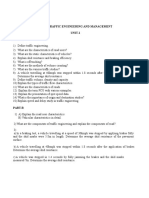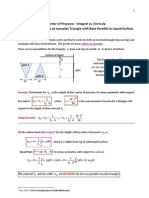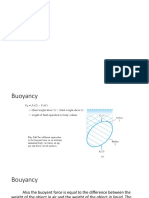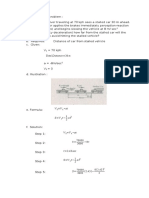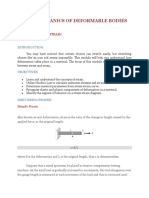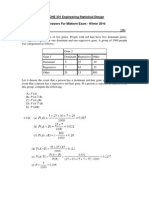Exercise Chapter 3
Uploaded by
NurAtieqahExercise Chapter 3
Uploaded by
NurAtieqahExercise 3: Linear Algebraic Equations And Matrices
1)
Numerical Methods
Use the graphical method to solve
x1 x2 3
4 x1 x2 2
Check your result using substitution method.
Answer: x1 1, x2 2
2)
Given the system of linear equations
3 x 2 7 x3 2
x1 2 x 2 x3 3
5 x1 2 x 2
Solve the above system using:
(a)
Cramers rule.
(b)
Gauss elimination with partial pivoting.
Substitute your result back into the original equations to check your solutions.
Answer: x1 0.9855, x2 1.4638, x3 0.9130
3)
Solve the following system using Nave Gauss elimination.
0.8 0.4
x 41
0.4 0.8 0.4 y 25
0.4 0.8 z 105
Answer: x 173.7553, y 245.0105, z 253.7658
Universiti Malaysia Pahang
Exercise 3: Linear Algebraic Equations And Matrices
4)
Numerical Methods
By using the Nave Gauss elimination method, solve the following system of
linear equations.
pq 0
2 p 3q 3r 1
p q r 1
2
2
1
Answer: p 5 , q 5 , r 5
5)
The upward velocity of a rocket is given at three different times as depicted in
Table 1.
Time,t ( s )
12
Velocity,v(ms 1 )
106.8
177.2
279.2
TEST 1
BUM2313 1112I
BAM2012 10111
Table 1
The velocity data is approximated by a polynomial as
v(t ) a1t 2 a2t a3
Solve the above system using Nave Gauss elimination as LU factorization. Use
four decimal places in your calculation.
Answer: a1 0.29048, a2 19.69, a3 1.0857
Universiti Malaysia Pahang
Exercise 3: Linear Algebraic Equations And Matrices
Numerical Methods
6) A typical statics problem to calculate forces in a bridge is represented by the
following:
TEST 1
BUM2313 1213I
BAM2012 10111
From the diagram, we obtain the following equations (these equations come from
statics theory):
Vertical forces:
F1 sin 69.3 F2 sin 71.1 F3 sin 56.6 + 926 = 0
Horizontal forces:
F1 cos 69.3 F2 cos 71.1 + F3 cos 56.6 = 0
Moments:
7.80 F1 sin 69.3 1.50 F2 sin 71.1 5.20 F3 sin 56.6 = 0
Rewrite the above equations in matrix form, AX B.
Hence, find the forces F1 , F2 and F3 using Gauss elimination as LU
factorization
u11 u12 u13
1 0 0
(Hint: Use DEGREE mode, U 0 u 22 u 23 and L l 21 1 0 )
0
l31 l32 1
0 u33
a.
b.
Answer: F1 425.5090, F2 1079.8749, F3 362.1843
Universiti Malaysia Pahang
Exercise 3: Linear Algebraic Equations And Matrices
7)
Numerical Methods
Given the system of linear equations in matrix form, AX b
9 0 0 x1 12
0 25 0 x 15
2
0 0 4 x3 6
(i)
Compute the Cholesky decomposition of [A].
(ii)
Hence, solve the above system.
Answer:(a ) U 0
(b) x1 , x2
8)
0 0
5 0
0 2
3
3
, x3
5
2
Given the system of linear equations
3x y 2 z 2
x 2 y 3z 1
2x 2 y z 3
(i)
Write the above system in matrix form, AX b .
(ii)
Compute the Crout decomposition of [A].
(iii)
Hence, solve the system of linear equations.
3 1 2 x 2
Answer:(a) 1 2 3 y 1
2 2 1 z 3
0
0 1 1/ 3 2 / 3
3 1 2 3
(b) 1 2 3 1 7 / 3 0 0
1
1
2 2 1 2 4 / 3 1 0
0
1
(c) x 1.1429, y 0, z 0.7143
Universiti Malaysia Pahang
Exercise 3: Linear Algebraic Equations And Matrices
9)
Numerical Methods
Solve the following system of equations using Jacobi method. Compute up to the
v 1
0
third iteration by taking the initial vector,
1 1 .
T
4 2 1 x1 11
1 2 0 x 3
2
2 1 4 x3 16
7
63
93
Answer:
x
,
x
,
x
1
2
3
8
32
32
10)
A civil engineer involved in construction requires 4800, 5800, and 5700 m 3 of
sand, fine gravel, and coarse gravel respectively for a building project. There are
three pits from which these materials can be obtained. The composition of these
pits are
Sand
Fine Gravel
Coarse Gravel
Pit 1 (x)
0.55
0.30
0.15
Pit 2 (y)
0.25
0.45
0.30
Pit 3 (z)
0.25
0.20
0.55
FINAL EXAM
BAM2012 1011I
BAM2012 10111
(i)
Set up the system of linear equations which modeling the problem above.
(ii)
Derive Gauss Seidel formula based on system of linear equations in (i).
(iii)
How many cubic meters can be hauled from each pit in order to meet the
engineers needs by using two iterations of Gauss Seidel method with
1000 m 3
initial estimation of sand, fine gravel and coarse gravel are 1000 m 3 .
1000 m 3
Universiti Malaysia Pahang
Exercise 3: Linear Algebraic Equations And Matrices
Numerical Methods
Answer:(a) 0.55 x 0.25 y 0.25 z 4800
0.30 x 0.45 y 0.20 z 5800
0.15 x 0.30 y 0.55 z 5700
k
k
4800 0.25 y 0.25 z
(b) x k 1
0.55
k 1
k
5800 0.30 x
0.20 z
y k 1
0.45
k 1
k 1
5700 0.15 x
0.30 y
k 1
0.55
(c) x 2660.8921, y 9030.5657 , z 4712.1754
11)
FINAL EXAM
BET2553 1011II
BAM2012 10111
Given the following matrix
0
2 1
A 1 2 1 .
0
1 2
Find the dominant eigenvalue of matrix A using power method. Take the initial
vector v
0
1 and perform three iterations.
0
Answer:The dominant eigenvalue of A is 6.2942
Universiti Malaysia Pahang
Exercise 3: Linear Algebraic Equations And Matrices
12)
Numerical Methods
Determine the solution of the simultaneous nonlinear equations
y x 2 x 0.5
y 5 xy x 2
Use the Newton-Raphson method and employ two iterations with initial guesses
of x y 1.2
Answer: x 1.36624, y 0.23673
13) Consider the circuit in Figure 1, where R1 = R2 = R3 = R4 = 5, R5 = R6 =R7 = R8 = 2
and
V1 = V2 = 5.
TEST I
BUM2313 1213II
Figure 1
Using Kirchoffs law, we have
V1 (i2 i1 ) R2 (i4 i1 ) R4 i1 R1
V2 i2 R3 (i2 i1 ) R2 (i2 i3 ) R5
0 i3 R8 (i3 i2 ) R5 (i3 i4 ) R7
0 (i4 i3 ) R7 (i4 i1 ) R4 i4 R6
Universiti Malaysia Pahang
Exercise 3: Linear Algebraic Equations And Matrices
Numerical Methods
which can be written in matrix form ( Ax b ) as
R1 R2 R4
R2
R4
R2
R2 R3 R5
R5
0
0
R5
R5 R7 R8
R7
R4
i1 V1
i V
0
2 2
i3 0
R7
R4 R6 R7 i4 0
(a)
Find matrix A by substituting the values of R1 , R2 , R3 , R4 , R5 , R6 , R7 and R8 .
(b)
By using Cholesky factorization
show that upper triangular matrix,
0
1.291
3.873 1.291
0
3.2145 0.6222 0.5185
.
U
0
0
2.3691 0.9804
0
0
2.4705
0
(c)
Hence, solve the loop currents i1 , i2 , i3 and i4 .
i1 0.2768
15 5 0 5
Answer : (a)A 5 12 2 0 (c) i2 0.3108
i3 0.0565
0 2 6 2
5 0 2 9
i4 0.1412
Universiti Malaysia Pahang
Exercise 3: Linear Algebraic Equations And Matrices
Numerical Methods
14) Thermistors measure temperature, have a nonlinear output and are valued for a
limited range. So when a thermistor is manufactured, the manufacturer supplies a
resistance versus temperature curve. An accurate representation of the curve is generally
given by
1
T
where T is temperature in Celsius, R is resistance in ohms, and x1 , x2 , x3 are constants of
x1 x2 ln R x3 (ln R ) 2
the calibration curve. Given the following for a thermistor
R (ohm)
T ( C )
911.3
30.131
636.0
40.120
451.1
50.128
TEST2
BUM2313 1213II
(a)
(b)
Set up the system of linear equations which modeling the problem above.
Rewrite in matrix form, [A][ x] [B] based on the system of linear equations in
(c)
(a).
Hence, find the dominant eigenvalue and its corresponding eigenvector of matrix
1, 0,1
A using power method. Given the initial vector, v(0)
and carry out
the first THREE iterations .
Answer : (a) x1 6.8149 x2 46.4425 x3 0.0332
x1 6.4552 x2 41.6696 x3 0.0249
x1 6.1117 x2 37.3527 x3 0.0199
(b) [A][ x] [B];
1 6.8149 46.4425 x1 0.0332
1 6.4552 41.6696 x 0.0249
1 6.1117 37.3527 x3 0.0199
(c) 0.9063 , 45.3249
0.8212
SUPPLEMENTARY EXERCISES
Universiti Malaysia Pahang
Exercise 3: Linear Algebraic Equations And Matrices
Numerical Methods
GAU SS ELIMINATION METHOD
1.
Given the equations
2 x1 6 x2 x3 38
3x1 x2 7 x3 34
8 x1 x2 2 x3 20
(a)
Solve by nave Gauss elimination. Show all steps of the computation.
(b)
Substitute your result into the original equations to check your answer.
Answer: x1 4, x2 8, x3 2
2.
An electrical engineer supervises the production of three types of electrical
components. Three kind of material-metal, plastic and rubber- are required for
production. The amounts needed to produce each component are
Component
Metal
Plastic
Rubber
(g/component) (g/component)
(g/component)
15
0.30
1.0
17
0.40
1.2
19
0.55
1.5
If totals of 3.89, 0.095, and 0.282 kg of metal, plastic, and rubber, respectively,
are available each day, how many components can be produced per day?
Answer:c1 90.60, c2 59.17, c3 80.28
Universiti Malaysia Pahang
Exercise 3: Linear Algebraic Equations And Matrices
Numerical Methods
3. A problem in electrical engineering that requires solutions of a system of equations is
shown in Figure 1.
TEST 1
BMM2112
1011I
Figure 1: Electrical Circuit.
Using Kirchoffs law, the currents i1 , i2 , i3 and i4, can be determined by solving the
following systems of equations:
9i1 4i2 2i3 24
4i1 17i2 6i3 3i4 16
2i1 6i2 14i3 6i4 0
3i2 6i3 11i4 18
(i)
Find i1 for the system of linear equations using Cramers rule. (Use 4
decimal
(ii)
places in your calculation)
Find i2 , i3 and i4, for the system of linear equations using Nave Gauss
Elimination methods. (Use 4 decimal places in your calculation)
Answer : (i) i1 4.0343
(ii) i2 1.6545, i3 2.8452, i4 3.6395
Universiti Malaysia Pahang
Exercise 3: Linear Algebraic Equations And Matrices
Numerical Methods
LU FACTORI ZATION
4. Given
2
1
3
2
1
2
2
1
1
1
2
9
1
5
3
1
1
7
1
2 x1 29
1 x 2 20
5 x3 61
1 x 4 41
8 x5 63
Show that
Then, solve the above system by using Cholesky factorization. (Use 5 decimal places)
Answer: x1 1, x2 2, x3 3, x4 4, x5 5
5. Given
2
1
3
2
Universiti Malaysia Pahang
1
2
2
1
1
1
2
9
1
5
3
1
1
7
1
2 x1 74
1 x 2 55
5 x3 151
1 x 4 106
8 x5 148
Exercise 3: Linear Algebraic Equations And Matrices
Numerical Methods
Show that
Then, solve the above system by using Cholesky factorization. (Use 5 decimal places)
Answer: x1 6, x2 7, x3 8, x4 9, x5 10
6. (a) Use nave Gauss elimination to factor the following system
10x1 2 x 2 x 3 27
3x1 6 x 2 2 x 3 61.5
x1 x 2 5 x 3 21.5
Then, multiply the resulting [L] and [U] matrices to determine that [A] is
produced.
(b) Use LU factorization to solve the system of equations in Prob 1. Show all
the steps in the computation.
0
0 0
2
1
1
1
0 0 5.4
1.7
Answer:(a) L U 0.3
0.1 0.1481 1 0
0
5.3519
(b) x1 0.5, x2 8, x3 6
Universiti Malaysia Pahang
Exercise 3: Linear Algebraic Equations And Matrices
7.
Numerical Methods
Decompose the following system into [L] and [U] using Gauss elimination as LU
factorization.
8 x1 x2 2 x3 20
2 x1 6 x2 x3 38
3x1 x2 7 x3 34
0
0 8
1
2
1
1
0 0 5.75 1.5
Answer: L U 0.25
0.375 0.2391 1 0
0
8.1087
8. (a) Perform a Cholesky factorization of the following symmetric system
8 20 15 x1 50
20 80 50 x 250
2
15 50 60 x 3 100
(b) Employ the result of the factorization [U] to determine the solution for the
right hand side vector.
2.8284 7.0711 5.3033
5.4772 2.2822
Answer:(a) U
5.1640
(b) x1 2.7344, x2 4.8828, x3 1.7187
9. Solve the following set of equations with LU factorization:
3x1 2 x 2 x 3 10
2 x1 6 x 2 4 x 3 44
x1 2 x 2 5 x 3 26
Answer: x1 1, x2 5, x3 3
Universiti Malaysia Pahang
Exercise 3: Linear Algebraic Equations And Matrices
10.
Numerical Methods
A liquid-liquid extraction process conducted in the Electrochemical Materials
Laboratory involved the extraction of nickel from the aqueous phase into an
organic phase. A typical set of experimental data from the laboratory is given
below.
Ni aqueous phase, a g l
2.5
Ni organic phase, g g l
8.57
10
12
TEST 1
BUM2313
1112I
Assuming g is the amount of Ni in the organic phase and a is the amount of Ni
in the aqueous phase, the quadratic interpolant that estimates g is given by
g x1a2 x2a x3 .
Solve the above system using Nave gauss elimination as LU factorization.
Answer: x1 1.14, x2 2.27, x3 8.55
11.
Consider the following system of linear equations:
TEST 1
BET2553
1011II
x 2 y 3 z 4
4 x 5 y 6 z 4
7 x 8 y 10z 7
(i)
Write down the coefficient matrix, A and the vector of right-hand-side
constants, b.
(ii)
Decompose A into lower matrix, L and upper matrix, U .
Answer:(i) A 4
(ii) A 4
Universiti Malaysia Pahang
2 3
4
5 6 b 4
7
8 10
0 0 1 2 3
1 0 0 3 6
2 1 0 0 1
Exercise 3: Linear Algebraic Equations And Matrices
Numerical Methods
FINAL
EXAM
BET2553
0910II
12. Given the system of linear equations
2 x1 2 x 2 x3 2
5 x1 x 2 3x3 0
3x1 4 x 2 x3 9
(i)
Transform the above system of linear equations in matrix form, AX B.
(ii)
Decompose matrix A into lower matrix and upper matrix.
(iii)
Hence, solve the system of linear equations using LU decomposition.
2 2
Answer: 5 1
3 4
x1 1, x2
1 x1 2
3 x2 0
1 x3 9
1, x3 2
TEST 1
BUM2313
1011II
13. An engineer supervises the production of three types of electrical components.
Three kinds of material are metal, plastic and rubber. This material required for
production. The amounts needed to produce each component are
The total of 2.12, 0.0434 and 0.1640 kg of metal, plastic and rubber, respectively
are available each day.
(i)
Transform the above problem into upper triangular matrix by using nave
Gauss elimination method.
(ii)
Hence,
find
the
solution
for
the
matrix
vector
{ x}
by
using LU decomposition method.
Answer: x1 0.02, x2 0.04, x3 0.06
Universiti Malaysia Pahang
Exercise 3: Linear Algebraic Equations And Matrices
Numerical Methods
ITER ATI VE METHOD S
14. Determine the solution of the linear equations
x1 2 x 2 10x3 42
10x1 3x2 x3 38
2 x1 10x 2 3x3 37
Using TWO iterations of the Jacobi iteration. Compute the estimated errors after
each iteration. If necessary, rearrange the equations to achieve convergence.
Let x 0 0,0,0 . Use THREE decimal places in your calculation.
1 x1 38
10 3
Answer: 2 10 3 x2 37
1
2 10 x3 42
x1 2.27, x2 5.72, x3 3.08
15. Determine the solution of the linear equations
2 x1 x2 5 x3 15
4 x1 x2 x3 7
4 x1 8 x2 x3 21
Using TWO iterations of the Jacobi iteration. Compute the estimated errors after
each iteration. If necessary, rearrange the equations to achieve convergence.
Let x 0 0,0,0 . Use THREE decimal places in your calculation.
4 1 1 x1 7
Answer: 4 8 1 x2 21
2 1 5 x3 15
x1 1.656, x2 3.875, x3 3.175
Universiti Malaysia Pahang
Exercise 3: Linear Algebraic Equations And Matrices
16.
Numerical Methods
An electrical engineer supervises the production of three types of electrical
components. Three kind of material-metal, plastic and rubber- are required for
production. The amounts needed to produce each component are
Component
Metal
Plastic
Rubber
(g/component)
(g/component)
(g/component)
15
0.30
1.0
17
0.40
1.2
19
0.55
1.5
The totals of 3.89, 0.095, and 0.282 kg of metal, plastic, and rubber, respectively,
are available each day. Using Gauss Seidal method with initial guesses of
c 0 0.05,0.05,0.05 , how many components can be produced per day?
T
Compute up to 2 iterations.
Answer: c1 0.1311, c2 0.0791, c3 0.0373
17. The sum of two acute angles in a right triangle is 90. The measure of
angle A is 6 less than 2 times the measure of the angle B.
FINAL
EXAM
BAM2012
1011I
(i)
Set up the system of linear equations which modeling the problem above.
(ii)
Derive Gauss Seidel formula based on system of linear equations in (i).
(iii)
Find the measure of each angle by using Gauss Seidel method with initial
45
guess of acute angle A and B are and stopping criterion of 20%.
45
Answer:(i) A B 90
A 2B 6
(ii) A k 1 90 B k
6 A k 1
k 1
B
A 54.75
(iii)
B 30.375
Universiti Malaysia Pahang
Exercise 3: Linear Algebraic Equations And Matrices
Numerical Methods
18. Given the following matrix
9 4
A
4 3
Find the dominant eigenvalue of matrix A and the corresponding eigenvector
1
using power method. Take the initial vector v 0 and compute up to THREE
1
iterations.
Answer: Dominant eigenvalue =11.014
Corresponding eigenvector =
0.5003
19. Given the following matrix
4 1 1
A 2 4 1
0 1 4
FINAL
EXAM
BET2553
1011II
Find the dominant eigenvalue of matrix A using power method. Take the initial
T
vector v 0 1 1 1 and stop the calculation when a 5% .
Answer: Dominant eigenvalue = 6.2
0.7742
Corresponding eigenvector = 1
0.5484
Universiti Malaysia Pahang
Exercise 3: Linear Algebraic Equations And Matrices
Numerical Methods
20. Given the following matrix A
1 2 0
2 1 2
1 3 1
FINAL
EXAM
BET2553
0910II
Find the dominant eigenvalue, 1 of matrix A and the corresponding eigenvector
using power method.
Take the initial vector v 0 1 1 1 and iterate until
T
a 20%
Answer: Dominant eigenvalue = 2.6363
0.0345
Corresponding eigenvector = 1
0.2414
21. Using three iterations, find the dominant eigenvalue, 1 of matrix A and the
corresponding eigenvector using power method for the following matrix A:
(a)
2 1 1
T
A 1 2 1 , v(0) 1 1 2
1 1 2
(b)
1 1 1
T
A 1 1 0 , v(0) 1 1 1
1 0 1
(c)
1 1 0
T
A 2 4 2 , v(0) 1 2 1
0 1 2
Answer: (a)
(b)
(c)
Universiti Malaysia Pahang
Corresponding eigenvector = 0.9167 0.75 1
Dominant eigenvalue = 3
Corresponding eigenvector = 1 1 1
Dominant eigenvalue = 5
T
Corresponding eigenvector = 0.2895 1 0.2105
Dominant eigenvalue = 3.6667
Exercise 3: Linear Algebraic Equations And Matrices
Numerical Methods
NONLINE AR SYSTEMS
22. Use the multiple-equation Newton-Raphson method with ONE iteration only to
determine roots of
x12 x1 x2 10
x2 3 x1 x2 2 57
Initiate the computation with guesses of x1 1.5 and x2 3.5.
Answer: x1 2.0360, x2 2.8439
23. Determine the solution of the simultaneous nonlinear equations
x2 5 y2
y 1 x2
using Newton-Raphson with TWO iterations and initial guesses of x y 1.5
Answer: x 1.6005, y 1.5616
24. Given
10x3 y 0
xy 1 0
Find the solution of the following equations using Newton-Raphson method with
TWO iterations and initial guesses of x 1.8552, y 0.4718.
Answer: x 1.6495, y 0.5320
25. Given
10x 2 y 2 10 0
x2 y2 4x 2 y 1 0
Find the solution of the following equations using Newton-Raphson method with
ONE iteration only. Initiate the computation with guesses of x y 1.
Answer: x 0.5, y 8
Universiti Malaysia Pahang
Exercise 3: Linear Algebraic Equations And Matrices
Numerical Methods
26. Given
TEST 2
BMM2112
1011I
10x 2 y 2 10 0
x2 y2 4x 2 y 1 0
Perform ONE iteration of Newton-Raphsons method to determine roots of the
above
equations. Initiate the computation with guesses of x 0.6295 and
y 2.4566.
[Answer: x 0.6296, y 2.4567 ]
REFERENCES
E. Balagurusamy, Numerical Methods, McGraw Hill, New Delhi, 1999.
R. K. Sankara, Numerical Methods for Scientists and Engineers, Prentice Hall, New
Delhi, 2005.
S. C. Chapra and R. P. Canale, Numerical Methods for Engineers, McGraw Hill, 2010.
S. Guha, Numerical Methods for Engineering and Science, Oxford University Press, New
Delhi, 2010
T. Veerarajan, Numerical Methods with Programs in C, McGraw Hill, New Delhi, 2006
Universiti Malaysia Pahang
You might also like
- Introduction To Geotechnical Engineering 2nd Edition Holtz Solutions Manual 190413014238No ratings yetIntroduction To Geotechnical Engineering 2nd Edition Holtz Solutions Manual 19041301423841 pages
- "Perfwall" - Perforated Wood Shear Wall Analysis: Program DescriptionNo ratings yet"Perfwall" - Perforated Wood Shear Wall Analysis: Program Description3 pages
- Camarines Norte State College: College of Engineering SummNo ratings yetCamarines Norte State College: College of Engineering Summ3 pages
- Wilmott, Paul - The Mathematics of Financial Derivatives100% (2)Wilmott, Paul - The Mathematics of Financial Derivatives338 pages
- Experiment No. 2 Sieve Analysis of Aggregates: Reference Standard: ASTM C 136-84a AASHTO T27-93No ratings yetExperiment No. 2 Sieve Analysis of Aggregates: Reference Standard: ASTM C 136-84a AASHTO T27-9317 pages
- Gauss-Jordan Elimination For Matrix 1x1 To 10x10No ratings yetGauss-Jordan Elimination For Matrix 1x1 To 10x103 pages
- Revised Curriculum Cea Civil - Engineering Sy. 2018 2019No ratings yetRevised Curriculum Cea Civil - Engineering Sy. 2018 201916 pages
- Solution To Problem 113 Normal Stress - Strength of Materials Review0% (1)Solution To Problem 113 Normal Stress - Strength of Materials Review5 pages
- Experiment No. 2 Familiarization of Hydraulic Bench ApparatusNo ratings yetExperiment No. 2 Familiarization of Hydraulic Bench Apparatus5 pages
- A Submerged Isosceles Triangle: Center of Pressure and Area Moment of Inertia100% (2)A Submerged Isosceles Triangle: Center of Pressure and Area Moment of Inertia4 pages
- 7 Osborne Reynold'S Demonstration: Mapúa UniversityNo ratings yet7 Osborne Reynold'S Demonstration: Mapúa University11 pages
- Advance Engineering Surveying: Lecture 6: Transition and Combined CurveNo ratings yetAdvance Engineering Surveying: Lecture 6: Transition and Combined Curve16 pages
- PART 2 Design Fabrication and Performance Evaluation of Portable Archimedes Screw For Pico Hydro Power Generation in Duangan Balamban Cebu100% (1)PART 2 Design Fabrication and Performance Evaluation of Portable Archimedes Screw For Pico Hydro Power Generation in Duangan Balamban Cebu24 pages
- Boq Estimate For 6 Units of One Bedroom ApartmentNo ratings yetBoq Estimate For 6 Units of One Bedroom Apartment4 pages
- Engineering Surveys - Compound, Reversed, Simple CurvesNo ratings yetEngineering Surveys - Compound, Reversed, Simple Curves11 pages
- Numerical Methods and Implementation in Geotechnical Engineering – Part 1From EverandNumerical Methods and Implementation in Geotechnical Engineering – Part 1No ratings yet
- ENGR 351 Numerical Methods College of Engineering Southern Illinois University Carbondale Exams Fall 2007 Instructor: Professor L.R. ChevalierNo ratings yetENGR 351 Numerical Methods College of Engineering Southern Illinois University Carbondale Exams Fall 2007 Instructor: Professor L.R. Chevalier13 pages
- 2021-22 Ordinaria ENUNCIADO - ENGLISH - SolutionsNo ratings yet2021-22 Ordinaria ENUNCIADO - ENGLISH - Solutions6 pages
- Articles: Real-Time Suggestions, Wherever You WriteNo ratings yetArticles: Real-Time Suggestions, Wherever You Write8 pages
- Mechanics of Deformable Bodies Module 2No ratings yetMechanics of Deformable Bodies Module 219 pages
- CHE 331 Engineering Statistical Design Answers For Midterm Exam - Winter 2010 Question 1 (2-166)No ratings yetCHE 331 Engineering Statistical Design Answers For Midterm Exam - Winter 2010 Question 1 (2-166)5 pages
- Oswaal CBSE Class 12th Toppers Answers Year-2020 MathematicsNo ratings yetOswaal CBSE Class 12th Toppers Answers Year-2020 Mathematics17 pages
- Tutorial: Good Practice in Well Ties: First Break October 2003No ratings yetTutorial: Good Practice in Well Ties: First Break October 200327 pages
- AN704: SCM7B: Application Note: Failure Rate Calculation and PredictionNo ratings yetAN704: SCM7B: Application Note: Failure Rate Calculation and Prediction1 page
- Traffic Assignment: Urban Transportation Systems PlanningNo ratings yetTraffic Assignment: Urban Transportation Systems Planning29 pages
- Hypothesis Testing - A Step-by-Step Guide With Easy Examples PDFNo ratings yetHypothesis Testing - A Step-by-Step Guide With Easy Examples PDF8 pages
- Introduction To Geotechnical Engineering 2nd Edition Holtz Solutions Manual 190413014238Introduction To Geotechnical Engineering 2nd Edition Holtz Solutions Manual 190413014238
- "Perfwall" - Perforated Wood Shear Wall Analysis: Program Description"Perfwall" - Perforated Wood Shear Wall Analysis: Program Description
- Camarines Norte State College: College of Engineering SummCamarines Norte State College: College of Engineering Summ
- Wilmott, Paul - The Mathematics of Financial DerivativesWilmott, Paul - The Mathematics of Financial Derivatives
- Experiment No. 2 Sieve Analysis of Aggregates: Reference Standard: ASTM C 136-84a AASHTO T27-93Experiment No. 2 Sieve Analysis of Aggregates: Reference Standard: ASTM C 136-84a AASHTO T27-93
- Revised Curriculum Cea Civil - Engineering Sy. 2018 2019Revised Curriculum Cea Civil - Engineering Sy. 2018 2019
- Solution To Problem 113 Normal Stress - Strength of Materials ReviewSolution To Problem 113 Normal Stress - Strength of Materials Review
- Experiment No. 2 Familiarization of Hydraulic Bench ApparatusExperiment No. 2 Familiarization of Hydraulic Bench Apparatus
- A Submerged Isosceles Triangle: Center of Pressure and Area Moment of InertiaA Submerged Isosceles Triangle: Center of Pressure and Area Moment of Inertia
- 7 Osborne Reynold'S Demonstration: Mapúa University7 Osborne Reynold'S Demonstration: Mapúa University
- Advance Engineering Surveying: Lecture 6: Transition and Combined CurveAdvance Engineering Surveying: Lecture 6: Transition and Combined Curve
- PART 2 Design Fabrication and Performance Evaluation of Portable Archimedes Screw For Pico Hydro Power Generation in Duangan Balamban CebuPART 2 Design Fabrication and Performance Evaluation of Portable Archimedes Screw For Pico Hydro Power Generation in Duangan Balamban Cebu
- Engineering Surveys - Compound, Reversed, Simple CurvesEngineering Surveys - Compound, Reversed, Simple Curves
- Numerical Methods and Implementation in Geotechnical Engineering – Part 1From EverandNumerical Methods and Implementation in Geotechnical Engineering – Part 1
- ENGR 351 Numerical Methods College of Engineering Southern Illinois University Carbondale Exams Fall 2007 Instructor: Professor L.R. ChevalierENGR 351 Numerical Methods College of Engineering Southern Illinois University Carbondale Exams Fall 2007 Instructor: Professor L.R. Chevalier
- Articles: Real-Time Suggestions, Wherever You WriteArticles: Real-Time Suggestions, Wherever You Write
- CHE 331 Engineering Statistical Design Answers For Midterm Exam - Winter 2010 Question 1 (2-166)CHE 331 Engineering Statistical Design Answers For Midterm Exam - Winter 2010 Question 1 (2-166)
- Oswaal CBSE Class 12th Toppers Answers Year-2020 MathematicsOswaal CBSE Class 12th Toppers Answers Year-2020 Mathematics
- Tutorial: Good Practice in Well Ties: First Break October 2003Tutorial: Good Practice in Well Ties: First Break October 2003
- AN704: SCM7B: Application Note: Failure Rate Calculation and PredictionAN704: SCM7B: Application Note: Failure Rate Calculation and Prediction
- Traffic Assignment: Urban Transportation Systems PlanningTraffic Assignment: Urban Transportation Systems Planning
- Hypothesis Testing - A Step-by-Step Guide With Easy Examples PDFHypothesis Testing - A Step-by-Step Guide With Easy Examples PDF

















